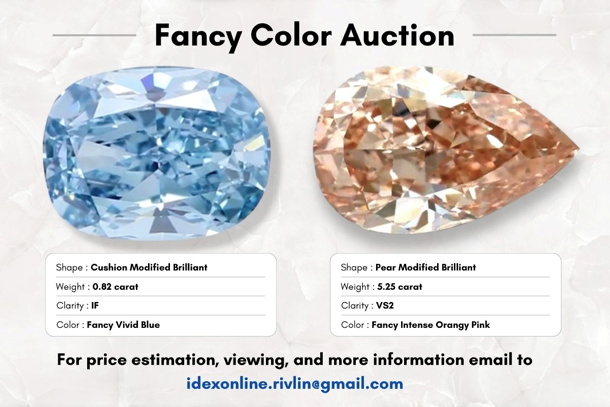Welcome to the SPECIAL SALE of FANCY COLORS organized by IDEX Online and Jacob Rivlin.com
May 29, 25
Sale Guidelines
- The diamonds are under exclusive option for the organizers.
- Bidding for the stones will close on Thursday, June 5th at 14:00 Belgian time.
- For viewing, or further details, please use the same email address.
- The organizers reserve the right, under special circumstances, to conclude the sale of one or both stones if they receive an offer that meets the seller's expectations.
Some Remarks about the 5.25-ct Intense Orangy Pink
Type IIa Diamonds
The 5.25-ct intense orangy pink is a type IIa diamond originating from South Africa. Less than 2 per cent of all diamonds (fancy and not fancy colors) are type IIa, which means they are an extra-pure diamond, with no nitrogen imperfections that are detectable by gemological equipment. In other words, the diamond has extremely small quantities of nitrogen - or in some cases none at all - to impact the color or any other gemologically relevant characteristics.
What makes this specific 5.25-ct orangy pink exceptionally rare as a type IIa diamond, is the fact that its graded as "intense". Following a study of about 90,000 pink diamonds, GIA researchers led by Dr. Sally Magaña, discovered that 25 per cent of pink diamonds are actually type IIa. But, following this research, most of those pink type IIa were the lighter color intensity. The stronger color saturation, i.e. intense, vivid, deep, and dark, were mostly found in the research with nitrogen impurities (non-type IIa). Therefore the 5.25ct, is an exceptionally rare diamond, as it is both type IIa and a fancy INTENSE orangy pink.
Pink, orangy pink, and purple variety of fancy color diamonds. Picture: GIA
Plastic Deformation - Most Expensive Diamonds
The 5.25ct orangy pink has plastic deformation lines that are common in the pink family of fancy diamonds. These plastic deformation lines are also the reason for the pink color of the 11.15ct Williamson Pink Star that sold for $57.7m and the 59.6ct Pink Star that sold for $71.2m.
Scientists assume that this natural phenomenon occurs sometime after a diamond crystallizes. High temperature and high pressure create those plastic deformation patterns, during the millions of years that a diamond travels deep in Earth's mantle or when it is elevated by an aggressive volcanic eruption up to the surface.
A 4.56-ct rough diamond with plastic deformation lines, highlighted in the sketch on the right. Images by Evan M. Smith, GIA.